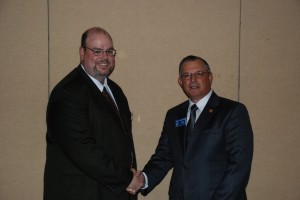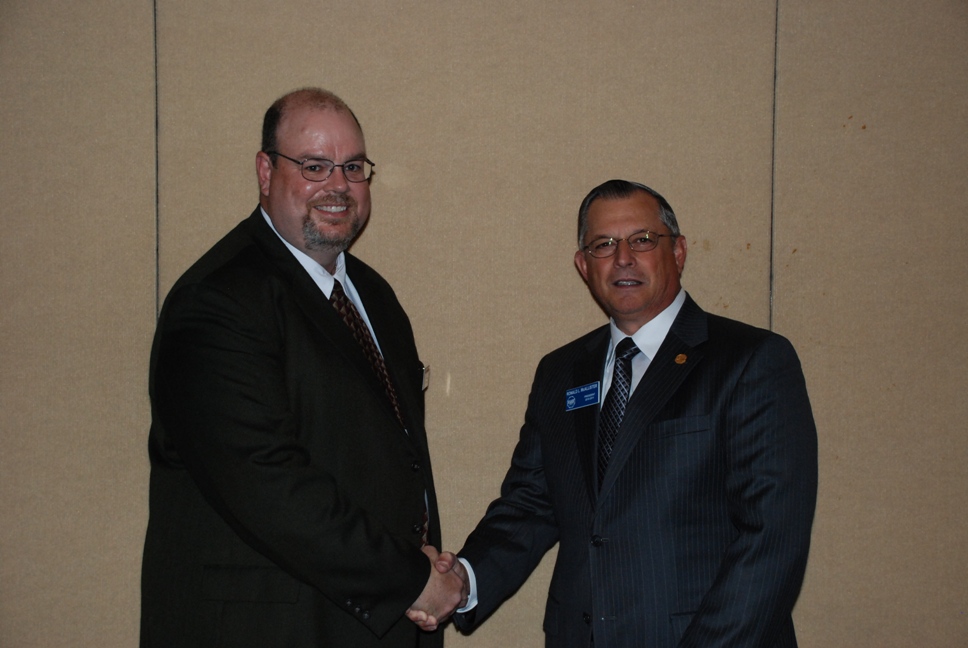
Jay Harmon, professor of agricultural and biosystems engineering, could not be more pleased with the results of this year’s 2011 American Society of Agricultural and Biological Engineers (ASABE) Annual International Meeting. Adding to the significant list of ASABE awards presented to Iowa State students and faculty, Harmon was named an ASABE Fellow and was a recipient of the Henry Giese Structures and Environment Award.
About a year ago, Harmon’s colleagues began quietly gathering information about his past successes. Hoping to make his possible selection as Fellow even more special, they chose to keep Harmon out of the loop. “I had an idea that I was up for some kind of award because department members have been nonchalantly asking me for information, but I didn’t realize it was for the ASABE Fellow nomination,” explained Harmon. “I was very surprised to hear that I was selected and honored that my colleagues took the time to nominate me.”
ASABE Fellow is the highest honor a member can receive. Members must have a minimum of 20 years experience in the engineering industry, including teaching, and a minimum of 20 years as a member of ASABE. Each year, 12 fellows are named, making up a group of .02 percent of the entire membership. Harmon was chosen “for his outstanding contributions to animal production systems and service to ASABE through research, extension, outreach, and teaching.”
Being selected as a Fellow and the 2011 Giese Award recipient all in one year is an extraordinary accomplishment that speaks to Harmon’s years of service. He says he was pleased to be selected for both honors, but one holds a special meaning for him. “I was considerably honored to receive the Henry Giese Structure and Environment Award because Giese was an ISU professor and the founder of the Midwest Plan Service (MWPS), an organization that I commit a lot of personal time to,” he explained.
MWPS is a publishing consortium consisting of 12 north central region land-grant universities and the U.S. Department of Agriculture (USDA). More than two million agricultural building plans and 1.3 million related publications have been disseminated through the group. Harmon is the professor-in-charge of MWPS, and is responsible for supervising employees and completing the necessary paperwork to run the facility. In addition, he contributes to writing publications.
According to Harmon, one of the main reasons he was selected for these awards was due to his involvement with the Ag Engineering Professional Engineers (PE) Exam, which is essentially the last step towards becoming a licensed professional engineer. Over the last eight years, Harmon has been involved in writing and assembling the exam. He is also part of the evaluation process as a member of a group that tracks questions with low statistics and decides whether or not the questions were fair.
To add incentive for ASABE members to take the test, Harmon helped put together a program that would pay for a portion of the testing fee. “Professional registration is an important step that I think every engineering graduate should take,” said Harmon. “I try to encourage unregistered faculty to take the PE exam as well to set a good example for students.”
Harmon also conducts a wide variety of research projects, many of which are most likely contributing factors to his recent honors. His long-term deep-bedded hoop swine project has achieved much success. The project focused on alternate building systems to raise pigs at a lower cost, appealing to small and start-up farms. “In order to find the best possible system, we researched environmental aspects; production efficiency; labor and economic efficiency; impact on meat quality; and animal welfare implications,” explained Harmon. These were all a part of a state-wide Extension program aimed educate swine producers about this style of production.
The project resulted in the construction of several thousands of these types of facilities across Iowa. In conjunction with the research, Harmon has visited Beijing to speak about the facilities in hopes of introducing the system to improve water conservation and retain manure nutrients in China.
Despite his considerable involvement with the PE exam, MWPS, and research, Harmon still finds time to teach two senior-level design courses for agricultural engineering students. The courses, which serve as ABE’s capstone courses, focus on developing proficiency in open-ended engineering design.
Given all the hard work and contributions Harmon has provided to the industry over the years, it is certain as to why he was deemed worthy of these two honors. In addition to his modest acknowledgement of the awards, he expressed a pragmatic view of his life recognitions. “Although I am enthused by my recent and past honors, the biggest honors don’t come with a plaque,” he stated. “In my eyes, student’s appreciation and recognition of my role in their life is the most meaningful acclamation I could receive.”
